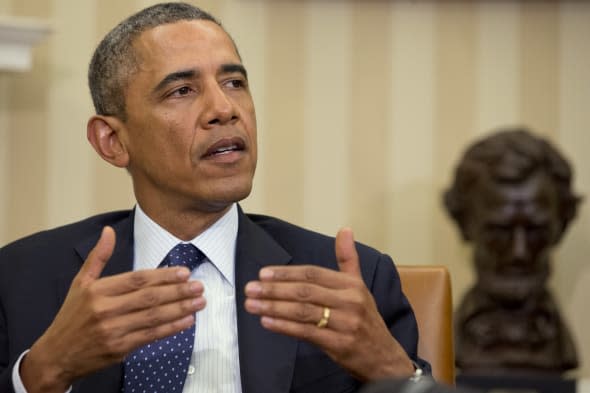Health care signups: More older Americans so far

WASHINGTON (AP) -- It's an older, costlier crowd that's signing up so far for health insurance under President Barack Obama's law, according to government figures released Monday. Enrollments are lower for the healthy, younger Americans who will be needed to keep premiums from rising.
Young adults from 18 to 34 are only 24 percent of total enrollment, the administration said in its first signup figures broken down for age, gender and other details. With the HealthCare.gov website now working, the figures cover the more than 2 million Americans who had signed up for government-subsidized private insurance through the end of December in new federal and state markets.
Enrolling young and healthy people is important because they generally pay more into the system than they take out, subsidizing older adults. While 24 percent is not a bad start, say independent experts, it should be closer to 40 percent to help keep premiums down.
Adults ages 55-64 were the most heavily represented in the signups, accounting for 33 percent of the total. Overall, the premiums paid by people in that demographic don't fully cover their medical expenses. Some are in the waiting room for Medicare; that coverage starts at age 65.
Some questions remained unanswered.
For example, the administration is unable to say how of many of those enrolling for coverage had been previously uninsured. Some might have been among the more than 4.7 million insured people whose previous policies were canceled because they didn't meet the law's standards.
"The uninsured folks for whom the law was intended don't seem to have signed up in nearly as high numbers," said Richard Foster, a former statistics chief for the Health and Human Services department. "There is still a huge unknown aspect to this."
But even if the age mix remains tilted toward older adults, "it's nothing of the sort that would trigger instability in the system," said Larry Levitt, an insurance expert with the nonpartisan Kaiser Family Foundation. Premiums would go up next year for the overhaul, along with taxpayer costs per enrollee, but not enough to push the system into a "death spiral" in which rising premiums discourage healthy people from signing up.
Levitt and other experts expected older, sicker people to be more heavily represented in the early numbers. They would have had strong motivation to persevere in the face of website dysfunction.
Still, he said "it underscores a need to heighten outreach efforts to young people." Adults ages 18-34 represent 40 percent of the target group for the health care law, according to a recent Kaiser study. Open enrollment ends March 31.
Considering that the federal health care website was down most of the time in October, administration officials said they were pleased that the percentage of young adults was as high as it was.
"We think that more and more young people are going to sign up as time goes by," said Gary Cohen, head of the HHS office in charge of Obama's push to cover the uninsured. And there's a hammer, too: Those who fail to sign up face a tax penalty in 2015 for being uninsured.
With Monday's numbers, a fuller picture has started to emerge of who's signing up.
Some of the highlights:
- The administration continues to play catch-up. Originally, officials hoped to sign up more than 3.3 million people through the end of 2013, nearly halfway to the goal of 7 million enrollments by the end of March. Instead, enrollment as of Dec. 31 was not quite 2.2 million.
- Fifty-four percent of those who signed up were women, a slightly higher proportion of females than in the population.
- Nearly four out of five who signed up got financial help with their premiums.
- The most popular coverage option was a so-called silver plan, which covers about 70 percent of expected medical costs. Three out of five people picked silver. One in five picked a lower-cost bronze plan. Only 13 percent picked gold, which most closely compares to the typical employer plan. Another 7 percent went for top-tier platinum plans, and about 1 percent picked skimpy "catastrophic" plans available only to certain groups of people, including those under 30.
- A few states accounted for a huge share of the enrollment. California alone had 23 percent of the signups. California, New York, Florida, Texas and North Carolina accounted for nearly half the total.
Officials remain confident they'll be able to get young adults interested. Insurers, nonprofit groups, and advocates are moving ahead with marketing campaigns that were put on hold when the federal website that serves 36 states was struggling.
Administration officials said that in the coming weeks they plan to increase outreach to young people in 25 communities located in states served by the federal website. That effort includes a national youth enrollment day on Feb. 15 and targeted outreach by sororities and fraternities, as well as Voto Latino, which focuses on Hispanic youth.
In Miami, 19-year-old college student Stacy Sylvain was one of the last-minute online signups as 2013 drew to a close. In about an hour, the part-time waitress signed up for a plan with a $158 monthly premium, with the feds kicking in $48. She has a $2,500 deductible. Sylvain said she had no trouble navigating the website.
"Many people have a preconceived notion that young people are healthy and don't need to go to the doctor," said Sylvain, who suffered a minor injury when she fell and hit her head during an indoor soccer class in 2012. "Not having to worry about being uninsured and the what-ifs has made an incredible impact on my life."

